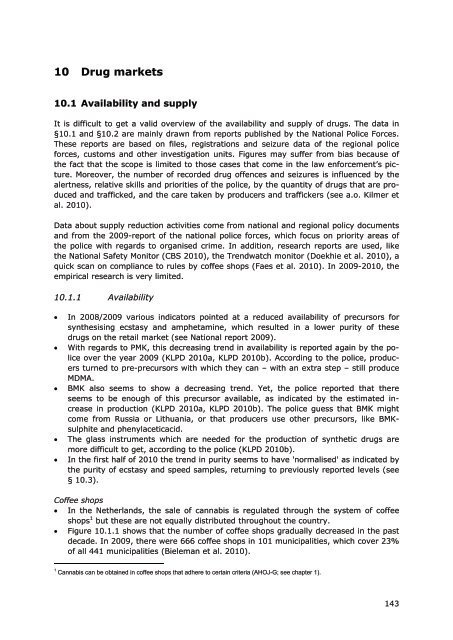The Netherlands Drug Situation 2010 - Trimbos-instituut
The Netherlands Drug Situation 2010 - Trimbos-instituut
The Netherlands Drug Situation 2010 - Trimbos-instituut
You also want an ePaper? Increase the reach of your titles
YUMPU automatically turns print PDFs into web optimized ePapers that Google loves.
10 <strong>Drug</strong> markets10.1 Availability and supplyIt is difficult to get a valid overview of the availability and supply of drugs. <strong>The</strong> data in§10.1 and §10.2 are mainly drawn from reports published by the National Police Forces.<strong>The</strong>se reports are based on files, registrations and seizure data of the regional policeforces, customs and other investigation units. Figures may suffer from bias because ofthe fact that the scope is limited to those cases that come in the law enforcement’s picture.Moreover, the number of recorded drug offences and seizures is influenced by thealertness, relative skills and priorities of the police, by the quantity of drugs that are producedand trafficked, and the care taken by producers and traffickers (see a.o. Kilmer etal. <strong>2010</strong>).Data about supply reduction activities come from national and regional policy documentsand from the 2009-report of the national police forces, which focus on priority areas ofthe police with regards to organised crime. In addition, research reports are used, likethe National Safety Monitor (CBS <strong>2010</strong>), the Trendwatch monitor (Doekhie et al. <strong>2010</strong>), aquick scan on compliance to rules by coffee shops (Faes et al. <strong>2010</strong>). In 2009-<strong>2010</strong>, theempirical research is very limited.10.1.1 AvailabilityIn 2008/2009 various indicators pointed at a reduced availability of precursors forsynthesising ecstasy and amphetamine, which resulted in a lower purity of thesedrugs on the retail market (see National report 2009).With regards to PMK, this decreasing trend in availability is reported again by the policeover the year 2009 (KLPD <strong>2010</strong>a, KLPD <strong>2010</strong>b). According to the police, producersturned to pre-precursors with which they can – with an extra step – still produceMDMA.BMK also seems to show a decreasing trend. Yet, the police reported that thereseems to be enough of this precursor available, as indicated by the estimated increasein production (KLPD <strong>2010</strong>a, KLPD <strong>2010</strong>b). <strong>The</strong> police guess that BMK mightcome from Russia or Lithuania, or that producers use other precursors, like BMKsulphiteand phenylaceticacid.<strong>The</strong> glass instruments which are needed for the production of synthetic drugs aremore difficult to get, according to the police (KLPD <strong>2010</strong>b).In the first half of <strong>2010</strong> the trend in purity seems to have 'normalised' as indicated bythe purity of ecstasy and speed samples, returning to previously reported levels (see§ 10.3).Coffee shops In the <strong>Netherlands</strong>, the sale of cannabis is regulated through the system of coffeeshops 1 but these are not equally distributed throughout the country. Figure 10.1.1 shows that the number of coffee shops gradually decreased in the pastdecade. In 2009, there were 666 coffee shops in 101 municipalities, which cover 23%of all 441 municipalities (Bieleman et al. <strong>2010</strong>).1Cannabis can be obtained in coffee shops that adhere to certain criteria (AHOJ-G; see chapter 1).143




